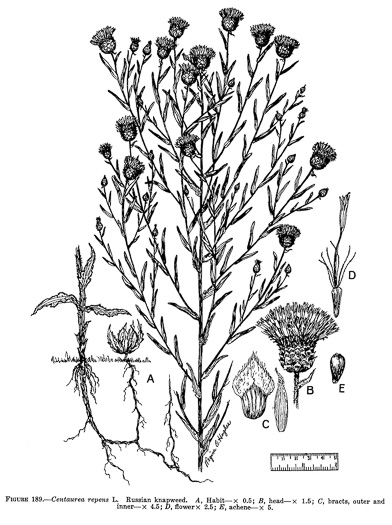Spermatophytes (seed plants): Angiosperms (flowering plants): Eudicots: Core Eudicots: Asterids: Campanulids: Asterales
WEAKLEY'S FLORA OF THE SOUTHEASTERN US (2/10/25):
Leuzea repens
FAMILY
Asteraceae__
Go to FSUS key
Dig deeper at SERNEC, a consortium of southeastern herbaria.
Check out EDDMapS.org to see where this has been reported.
SYNONYMOUS WITH
PLANTS NATIONAL DATABASE:
Acroptilon repens
FAMILY
Asteraceae__
SYNONYMOUS WITH Floristic Synthesis of North America. BONAP (Kartesz, 2021)
Rhaponticum repens
SYNONYMOUS WITH The families and genera of vascular plants (Kadereit & Jeffrey, 2007)
Rhaponticum repens
SYNONYMOUS WITH Flora of North America north of Mexico, vol. 19-20-21 (2006)
Acroptilon repens
SYNONYMOUS WITH Britton & Brown Illus Flora of Northeast US & adjacent Canada (Gleason, 1952)
Centaurea repens
COMMON NAME:
Russian Knapweed
To see larger pictures, click or hover over the thumbnails.
WEAKLEY'S FLORA OF THE SOUTHEASTERN US (2/10/25):
Leuzea repens
FAMILY
Asteraceae__
SYNONYMOUS WITH
PLANTS NATIONAL DATABASE:
Acroptilon repens
FAMILY
Asteraceae__
SYNONYMOUS WITH
Floristic Synthesis of North America. BONAP (Kartesz, 2021)
Rhaponticum repens
SYNONYMOUS WITH
The families and genera of vascular plants (Kadereit & Jeffrey, 2007)
Rhaponticum repens
SYNONYMOUS WITH
Flora of North America north of Mexico, vol. 19-20-21
Acroptilon repens
SYNONYMOUS WITH
Britton & Brown Illus Flora of Northeast US & adjacent Canada (Gleason, 1952)
Centaurea repens
If a search such as "Carex leptalea var. leptalea" doesn't deliver the results you want, try "Carex leptalea".
Or, to minimize chances of a misspelling, try just "Carex le".
Less is more: If "pencil flower" doesn't deliver the results you want, try "pencil".


